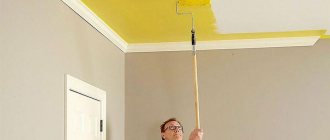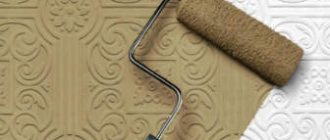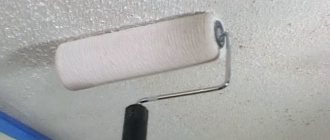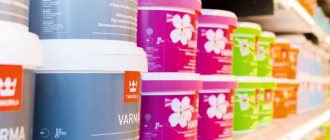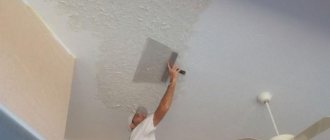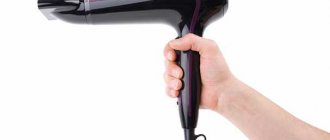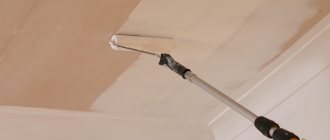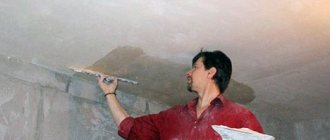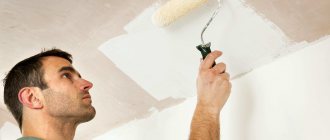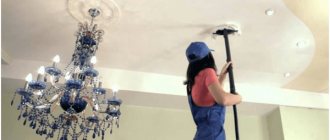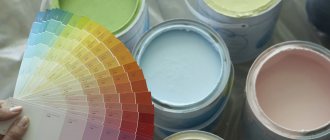Painting helps change the appearance of decorative wall coverings without any extra effort. A person who carries out repairs with his own hands has a question about whether it is possible to paint paper wallpaper with water-based paint. Painting such coatings is permitted, but a number of rules must be followed.
On the left is paper wallpaper, on the right is white vinyl wallpaper with a paintable texture.
Features of non-woven wall decor
Decorative stripes are made of non-woven fabric. It is formed from natural cellulose fibers that are woven into a durable fabric. To give it even greater strength, impregnations and fiber additives made from polymers are used. The panel made in this way becomes the basis for decoration. Another layer is applied to it and embossed. The result is a textured or smooth finishing fabric.
Various materials are applied to the cellulose substrate. If it is non-woven, you get a durable finish that is easy to stick on. One of its advantages is the possibility of repainting. Wallpaper is produced specifically for painting. Such markings must be present on their packaging. These are white or light yellow canvases with a pattern or smooth. After gluing, they are painted. As a rule, the material can withstand 8-10 painting cycles.
Conclusion
By watching the video in this article you can get more detailed information on how to apply dye to wallpaper. At the same time, based on the article presented above, it should be concluded that such an operation does not have complex stages and does not require certain skills. Therefore, even a novice master can cope with it (see also the article “Paint for liquid wallpaper - how to choose and how to use”).
Did you like the article? Subscribe to our Yandex.Zen channel
How long can you repaint?
Unfortunately, it often happens that after wallpapering a room, it needs to be repainted in a different color. Let's say you didn't like the color or the interior changed. Or maybe, after a certain time, the previous color simply begins to get boring. A reasonable question arises whether it is possible to repaint the wallpaper and how many times it can be repainted.
Gone are the days when cosmetic repairs meant obligatory wallpapering. The furniture had to be taken out, the old wallpaper had to be torn off, and new wallpaper had to be put up. This took a lot of time and effort.
Today, you can only repaint a certain section of the wall in the color you like, and that’s it – the repair is completed.
Manufacturers have taken care of their customers and produce textured wallpaper, the protrusion of which is sufficient to carry out painting work at least five times. Until the drawing is flush with the paint. Usually the quantity is indicated on the packaging; there are specimens intended for re-dying more than ten times.
But in this case you won’t be able to save money.
It is also important what kind of glue they were used to attach to the wall. If cheap glue was used, then after the wallpaper “gains weight” it will slide off the wall under its own weight
It should be borne in mind that matte paints clog up the design, unlike glossy ones, which, on the contrary, emphasize it. It is advisable to use water-based paint; it does not create crusts.
When repainting, you can experiment with the color scheme, for example, a combination of dark blue colors with white paint - you get a pastel color. And when you mix yellow and blue paint, a green tint comes out. If you mix yellow and red it becomes orange.
Bright or colorful combinations are obtained by mixing green and red colors with white paint. You can experiment with your children, the main thing is just not to forget what was mixed with what, in order to repeat this color in the future.
Is it possible to paint paper wallpaper?
There are times when there is no point in doing this type of work. Cheap paper wallpaper is easier to re-stick than to update. If they have a good relief pattern, coloring is quite possible. At the same time, it is very important to follow the technology.
Repair specialists have different opinions about painting paper-based wallpaper. They absorb water from the paint, become wet, become deformed, and even move away from the walls. Therefore, before painting paper wallpaper, preliminary surface treatment is necessary.
How to paint a wall covered with wallpaper for painting
Options for painting walls covered with wallpaper vary depending on the area to be painted, the chosen composition and the painting method - with a brush or a spray gun.
How to choose paint
The choice of paint depends on the purpose of the room in which the renovation is being carried out.
So, for example, in the kitchen or in the nursery it is important to use washable paint that allows frequent wet cleaning and is resistant to detergents, in the corridors of public buildings - which has high wear resistance, in medical institutions - special paints with an antibacterial effect, etc. The rules for choosing paint for wallpaper and when choosing paint for putty walls are the same
Which roller to paint with?
Any roller can be used, but paint manufacturers recommend using fur or velor rollers with medium pile (6-10 mm) for this type of work. For an additional decorative effect, you can use a textured roller to apply a second or third layer of the main shade, or to apply a layer of a different color.
How many layers of paint will be required
Usually 2 layers are enough, but, for example, when painting a dark base in light colors, 1-2 additional layers may be required.
Step by step guide
To paint the walls you will need:
Roller (180-300 mm, the wider the better, but it is important that the roller is comfortable to hold). A narrow thin roller or brush for removing corners. Paint tray with a special surface for rolling out a roller. Facade spatula with a width of at least 250 mm. Masking tape. Mixer for paint. A container for mixing paint if you plan to paint yourself. Damp cloth. Broom or vacuum cleaner.
Dye.
First of all, clean the base from dust with a broom or vacuum cleaner.
You should carefully check the quality of the wallpaper, paying special attention to the seams.
It is recommended to cover the floor and other horizontal surfaces with paper or a paint awning. Cover the surfaces adjacent to the area to be painted with masking tape, carefully pressing the edges.
The paint should be mixed thoroughly. Thick paint can be slightly diluted with water.
If the paint is tinted independently, it is necessary to tint the entire required volume of paint in one container at once to avoid differences in shades.
Initially, the corners are painted with a narrow roller or brush, then the main plane of the wall is painted with a wide roller. You should paint with horizontal movements with the greatest possible amplitude, without changing the pressure on the roller. The speed of movement of the roller is selected experimentally, fast enough to avoid drips, but at the same time so that there is no splashing. It is recommended to avoid pauses while painting one wall. If the paint is poorly painted or streaks appear, apply another layer.
Technological features of painting modern wall and ceiling coverings
Having dealt with the intricacies of coloring liquid and non-woven wallpaper, let’s move on to a description of the technology itself. This process looks like this:
- In the first stages, prepare the surface.
- Next, work with the paint: add the desired shade of color (it is recommended to take 1-2 shades darker than the wallpaper itself), stir until the color and consistency are uniform. Choose water-based or acrylic paint for painting liquid or non-woven wallpaper.
- For application, use a roller, and if the work requires urgency, you can resort to automating the process, armed with a spray bottle.
- Let the surface dry thoroughly.
As you can see, painting non-woven wallpaper with water-based paint, wall and ceiling surfaces finished with liquid wallpaper is not a problem. This is a very real and affordable option to decorate a room in a new way, which does not require any special time, financial or labor costs.
Please note that plain non-woven wallpaper can be painted by applying a special roller that leaves imprints. This option looks interesting in the interior.
Anyone can cope with such work, even if you have never encountered repair work, because you have definitely had to paint or whitewash the interior of a house at least once in your life.
Use the recommendations given for processing wallpaper and follow the advice of experts to avoid possible difficulties during the work.
Tools for work
Having decided whether it is possible to paint non-woven wallpaper, and with what means to do this, prepare the tools. The best result will be obtained by a spray gun or, as it is also called, a spray gun. Its use allows you to get an even coating without the slightest defects. Professional pneumatic devices are expensive and massive. A compact household version with an electric motor is suitable for the home.
A roller is used to apply the coloring agent. For smooth panels, choose a fur coat with short pile, for textured ones - with long pile. In any case, craftsmen recommend taking sheepskin or velor. They do not leave clots, streaks or air bubbles. Use a brush to paint hard-to-reach areas. You can paint the entire surface with it, but it is very difficult to do it evenly. There are almost always streaks left. Therefore, only hard-to-reach and small fragments are painted with a brush.
How to prepare for work
Before starting repairs, you need to prepare the following materials and tools:
When painting wallpaper with a roller, the use of a tray for rolling in the tool is mandatory.
- roller with a velor nozzle with long pile;
- foam cylinder for processing embossed wallpaper;
- narrow flat brush;
- tray for rolling in tools;
- masking tape;
- water-based coloring agent;
- color.
The preparatory stage includes the following steps:
- Tinting paint. You can perform this action at a hardware store. Large companies offer a computer shade selection service. The program calculates the amount of tint required to create the selected color. The information is stored in the computer's memory, so there are no problems with ordering additional paint.
- Cleaning wallpaper. It is necessary to free the coating from dust and contaminants that could deteriorate the applied decorative layer. The walls are wiped with a damp cloth. The paper surfaces are dried for 2-3 hours, after which painting begins.
What else needs to be considered when choosing a material?
The main thing is choosing the right texture. If you settle on a correct, mathematically precise drawing - a geometric pattern, the wall will come out very strict and monotonous. With an unpredictable and chaotic arrangement of the image (imitation of crumpled paper), it may seem rough and careless.
Without wanting to resort to extremes, you can choose a middle ground - for example, fine texture in a chaotic pattern or zigzag bulges that soften chaotic lines. You can choose a repeating pattern, but with complexly curved, streamlined lines, leaves, flowers, diluting the monotony and not associated with geometry.
The size of the drawings is also of great importance. The imitation of large cracks attracts the eye, while small cobwebs escape attention. But the larger the image fragments, the closer the object is visually perceived. Therefore, such a print on wallpaper will not suit a small room; it will make it even smaller. For small rooms, it is better to choose a smooth canvas, a small chaotic texture or a repeating pattern of a small size - up to ten centimeters.
You cannot say that some designs or textures are beautiful, fashionable, etc., and others are not. Each consumer will choose something according to their mood and discretion. If you are a fan of regular, repeating, strict and clear lines, wallpaper with simple elements is suitable for you. And one more nuance: pronounced textures do not combine with glossy paint. Such work will look, to put it mildly, strange. Large-textured wallpaper and matte and semi-matte dyes fit together more organically.
Summarize
So, we hope that now you have a more detailed idea of whether it is possible to paint paper wallpaper and how to properly organize the entire work process. To give a brief summary, we can say that for a good result you will need to properly prepare the working surface of the walls, repair damaged fragments, and also make a special layer that is highly resistant to moisture.
Do not forget that when painting you must use acrylic or water-based paint, which is applied using special tools. When carrying out work, all instructions must be strictly followed. This will guarantee that the result of your work will please both you and all your loved ones.
How to paint wallpaper for painting yourself
An important rule is that all paints and varnishes must be applied to a dry surface. If the wallpaper has been pasted recently, be sure to wait for it to dry completely.
Only after this can you start painting. A completely logical question may arise here: “How long should you wait after gluing the canvases?” On average, the interval between pasting and painting is about 24 hours.
Typically, wallpaper for painting is white. That is why you can choose any tone to paint them. If you need to repaint dark wallpaper, you should first apply a neutral paint, and only then the desired color.
There is nothing complicated about painting wallpaper yourself, you just need to adhere to certain rules and follow the sequence of the process
The entire process of painting wallpaper with your own hands can be divided into certain stages:
- Preparing the paint. If necessary, the coloring composition is diluted, brought to the desired consistency and mixed thoroughly. The prepared mixture should be homogeneous without any unnecessary inclusions.
- Using masking tape, glue all the joints of the walls with the floor and ceiling. Also, adhesive tape is applied to baseboards and other elements that need to be protected from paint.
- Surface painting. This must be done in one go, because if the work is stopped and then continued, very noticeable joints will appear on the walls. First, use a brush to paint the junctions and corners, and then roll the walls with a roller. In this case, you need to move from the ceiling to the floor (that is, from top to bottom), without leaving gaps, even if painting is done in several layers. This method will allow you to apply paint without streaks.
- After the first layer has completely dried, you can apply the next layer of paint. Usually two coats are enough to achieve the desired result.
This video will help you thoroughly understand the nuances of painting wallpaper:
Painting wallpaper with water-based paint requires first giving it the desired shade. You can do this in two ways:
On one's own. To do this, you need to purchase a liquid or powder color and gradually add it to the paint in small portions
Here it is important not only to guess the amount of pigment, but also to thoroughly mix the paint using a whisk or mixer. The intensity of the shade is affected by a certain amount of color
Typically, manufacturers put a color palette on the packaging. It is worth remembering that the tone will become darker in the container. To get the result you want, you will need more color. You also need to consider the type of roller you will use. It is important what layer of paint it leaves: dense or thin.
Color the paint in specialized stores. You will need to choose the shade you like, and the computerized system itself will add the required amount of pigments and mix the paint until smooth.
Assortment for painting
On the shelves of building materials stores there is a huge assortment of wallpaper: traditional, liquid, special non-woven wallpaper for covering. It is the last of this number that are purchased most often, because they make it possible to modify the design of the pasted canvases through new painting without carrying out major repair work.
Please note, to avoid color distortion, when painting, choose plain rolls. But it is best to give preference to white canvases.
Types of wallpaper for painting: their advantages and disadvantages
When choosing a suitable product, its structure, thickness, and coating are taken into account. Not all wallpaper can be painted. Manufacturers produce several types of special models, which differ in the material used in their production:
- non-woven;
- vinyl;
- fiberglass.
These products are a fairly durable material that has a layered structure and is characterized by moisture-resistant qualities. Their surface can be smooth or textured, with a pattern or ornament. Initially they are white, there are cream versions, very rarely colored ones, which do not need to be painted.
Vinyl
Vinyl wallpaper intended for painting consists of two main layers. The bottom one is made of non-woven fabric. It serves to glue the material to the wall surface. The top one is made of polyvinyl chloride. Such models will be an ideal option for decorating premises in new buildings that are about to shrink.
There are three types of standard vinyl wallpaper: washable, structural, based on foamed PVC, hot stamping. Only models with a foam top layer without embossing are used for painting. Their advantages include:
- they mask the unevenness of the walls;
- have good moisture resistance;
- resistant to fire;
- treated with a special antifungal coating;
- They have a wide range of textures and patterns.
The main disadvantage of this material is that vinyl coating is quite fragile, it is easy to scratch and damage. Paint solves this problem only partially.
Glass wallpaper
The products are produced by weaving filamentary glass fibers formed as a result of heating the glass. To give strength, the material is coated with a special starch-based glue. The result is an environmentally friendly product. All existing fiberglass models can be divided into:
- Smooth. Characterized by high density. They are mainly used for ceiling cladding.
- Embossed. They have different designs, three-dimensional images, and ornaments. Used for wall decoration.
Finished products differ in density. According to this characteristic, 3 main varieties are distinguished. The first one is of the highest quality, the third one allows for defects. Manufacturers produce white and colored versions. Among the main advantages of wallpaper are:
- high environmental qualities;
- tensile density can reach up to 3 tons per m²;
- long service life;
- the material is not electrified;
- easy care;
- wallpaper can be repainted up to 20 times;
- they can be used in rooms with high humidity;
- are not afraid of ultraviolet rays, do not fade;
- fireproof.
Flaws:
- high price;
- when working, it is necessary to use protective equipment, since when cutting the material crumbles;
- complex dismantling work;
- Painting requires a large amount of dye.
Non-woven
The product is produced in rolls. There are smooth and textured options, which are made on the basis of non-woven fabric. It consists of chemically modified cellulose fibers pressed together. Due to its characteristics and relatively low cost, the finishing material is in demand. The main advantages of this raw material include:
- environmentally friendly product;
- allows you to change the appearance of the interior, the surface can be repainted up to 15 times;
- easy installation, you can do the work yourself;
- easy care;
- allows you to hide small defects, small cracks;
- is not afraid of shrinkage of buildings;
- provides good sound insulation.
Flaws:
- heavy weight;
- after several repaints, the texture is hidden under a layer of paint, especially under oil paint;
- thin models can stretch during pasting.
Tips before painting wallpaper yourself
1️ Wallpaper must be glued very well!
Inspect them carefully and immediately glue small loose areas. If your wallpaper is very old and has completely started to peel off, then it is better to tear it off and not waste time, effort and money on painting it.
- 2️ For painting, choose water-based, moisture-resistant paint. It doesn’t have to be expensive, just make sure it’s marked for painting wallpaper
- 3️ For structural wallpaper, buy a lint roller, this way the wallpaper will be painted better. Immediately buy a small 10-15 cm roller for painting areas under pipes and radiators.
4️ Paint only in good daylight! This is the only way you will see whether the paint is applied evenly. A lot depends on the uniformity of the first layer! If you apply the first layer of paint unevenly, then you will struggle to even out the tone.
- 5️ In order for the first layer to lay down evenly, the paint must be diluted with water so that it is liquid. Do not paint the first layer thick, it will not lie flat. The proportions for dilution are indicated on the jars.
- 6️ The richer and brighter the original color of the wallpaper, and the lighter the paint, the more layers will be required.
- 7️ Calculate how many square meters will need to be painted and calculate the amount of paint needed. Manufacturers indicate the amount of paint per 1 square meter in 1 layer. Multiply this value by the number of square meters of walls you have, minus windows and doors, and then by the number of layers and get the required amount of paint.
- 8️ Buy a little more rather than less. Especially if the paint is colored or tinted. Because the color may be different in different batches. It’s better to have it left, and then you can touch up the stained areas, rather than not having enough, you run to buy more and it turns out that the shade doesn’t match.
IMPORTANT: It’s easier to repaint the entire wall than to end up with the color that came out of mixing.
Features of the design of different rooms
Thanks to the use of paintable wallpaper in any room, you can create accents on the bright shades of the walls.
That is why paint colors for wallpaper for painting must be chosen based on several factors:
- room dimensions. The smaller the space, the lighter the shades used should be;
- lighting. Insufficiently lit interiors must be brightened using colors of a delicate palette;
- planning features. You can create an accent on niches and ledges in the interior by decorating the wallpaper for painting in brighter or darker colors;
- purpose of the room. The colors of the wallpaper for painting should not contradict the general atmosphere of the interior.
In addition to the materials themselves in the kitchen, which must have moisture-resistant and fire-resistant properties, pay attention to the paint itself for their design. It is advisable to paint the wallpaper in the kitchen with paint that will withstand exposure to fire, does not contain toxic substances and does not fade with constant contact with sunlight
In the kitchen interior, it is possible to paint wallpaper in two colors: darker, stain-resistant shades are used to decorate the work area, and lighter and more delicate shades are used to decorate the walls in the dining area of the room.
In addition to practical functions, such contrasts will help zone the space and highlight some accents in the design.
The choice of wallpaper color for painting for the kitchen plays a huge role. Since the style of this room should suit the appetite, it is advisable to focus on soft and warm shades. It is acceptable to use bright and rich contrasts: for example, green or yellow shades will charge with energy.
Painting the wallpaper in the kitchen in dark shades is only permissible if the gloomy interior is diluted with light inserts or appropriate furniture.
What color should you paint the wallpaper in the hall or living room? Since these spaces are designed for entertaining and family fun, you can get creative and create stylish color combinations. In the living room, such wallpaper colors as red, yellow, blue, beige and even black and white palettes are acceptable. The main thing is that the shade you choose matches the style of the interior.
Tip: if you want to create an accent on one of the walls in the room, use more saturated shades or draw stylish patterns on the surface of the wallpaper using paint and stencils.
Most often, in the living room, wallpaper for painting is chosen with a relief texture: when using such materials, you can emphasize the cozy atmosphere even with the help of a monochromatic design. In addition, it is easier to choose furniture, textiles and accessories for single-color coverings.
A living room interior with paintable wallpaper will look original and elegant in any style, so you can incorporate elements of such trends as loft, modern, classic, art deco, Provence and many others into your design.
In the bedroom, wallpaper for painting should emphasize a calm and peaceful atmosphere, and therefore it is advisable to use warm and soft shades. Bright elements in this design are possible only in small quantities and only in areas of the room that are not available for contemplation during relaxation.
Most often, bedroom wallpaper is painted in only one color (for example, pink, beige or blue), but harmonious combinations are also possible. For example, blue, red or brown can be used to paint the wall behind the bed.
Painting wallpaper in a children's room should be done taking into account the age of your child. For the little ones, you can use delicate and warm shades.
Preschool children need to develop, so for such rooms zoning and, accordingly, the use of several colors at once are acceptable. For example, children's wallpaper in bright shades can be used in a play area, calm ones in a sleeping area, cold and restrained shades in an area intended for study.
The color scheme for teenage rooms should depend on the gender and preferences of your children.
Wallpaper to be painted in the hallway should be strong and durable enough, and the shade itself should match the color of the furniture. It is advisable to use combinations of dark and light colors: dark colors will protect your walls from stains, and light colors will dilute the gloomy interior.
We told you about the basic principles and features of using wallpaper for painting and are confident that now your interior will look more fresh and interesting. In addition, wallpaper of this type is a unique opportunity to create absolutely any pattern on the walls and use several shades at once that will maintain a lively and positive atmosphere in the room.
https://www.youtube.com/watch?v=1aXT40vW1Gk
The benefits of painting wallpaper
Among the main positive factors, those who had to deal with such work identify the following:
- The ability to hide dirt and stains that have appeared on the surface of the wallpaper over many years of use. This is the easiest and most budget option to modify the interior.
- A chance to give the coating a fresh, updated look if it has faded due to sunlight.
- Numerous treatments if necessary.
- Painting wallpaper with water-based paint yourself makes it possible to choose any shade to create a harmonious, balanced interior design to your liking.
- The work is simple.
Wallpaper paint for interior work
The stores offer a wide range of paints that can be used to paint wallpaper. Consumption and price will depend on a number of factors: manufacturer, types of wallpaper and the number of layers applied. Before you buy paint for painting wallpaper, it is recommended to subtract its consumption; for this, the following parameters are taken into account:
- The area of all walls that will be painted is measured.
- The areas of window and door openings are subtracted.
- It is determined how many layers will be applied.
You need to choose paint based on operating conditions and type of wallpaper. In addition, it is recommended to follow these tips:
Choose a color palette that will match your interior design. Please note that the color in the jar and on the wall will be slightly different. In the second option, the tone will be slightly darker. Choose compounds that are marked for use for interior work.
Other options may be hazardous to the health of residents. Choose dyes that are completely environmentally friendly, so be sure to pay attention to the composition of the product. If it contains unknown components, then it is better to choose a different paint. Check quality certificates indicating product safety
With their help, you can avoid buying counterfeits and low-quality goods. First, apply the paint to a small part of the wallpaper to evaluate how it applies and what color you will end up with.
Acrylic paint for wallpaper
This option is classified as a water-based composition, which includes a binder - acrylic resin. The paint is available in a wide range of color shades. It can be used for paper and vinyl wallpaper, as well as for latex-based options, acrylic and non-woven coverings. Acrylic wallpaper paint for painting can be used up to 15 times. High-quality compositions are economical, so in most cases one layer is enough.
The advantages of acrylic paint for wallpaper include the following:
- moisture resistance;
- the coating is “breathable”;
- does not fade in the sun;
- has no unpleasant odor;
- is safe;
- retains color for a long time.
Latex paints for wallpaper
The features of this coating option include the fact that it forms a luxurious structure with a characteristic silkiness. After application, a film is created on the surface thanks to fine particles, which stick together when the liquid evaporates, creating a dense coating. Latex wallpaper paint for painting is not cheap, but it has excellent characteristics:
- ensures long service life;
- easy to clean from dirt;
- does not deteriorate due to moisture;
- dries quickly;
- can be used on all wallpapers;
- presented in different color shades.
Water-dispersion paint for wallpaper
One of the most popular options for painting wallpaper, which does not contain any harmful components, oils or resins, so the composition is best for use in residential areas. It has a light scent and dries quickly. Water-dispersion paint is available in a wide range of colors. It has several subspecies:
- For textured wallpaper, water-dispersion acrylic paint will be an excellent option. You can use it for fiberglass.
- There is paint that is not based on acrylic. It is characterized by a long service life. The composition includes acrylic latex and butadiene styrene, which provides elasticity.
Water-based paint for wallpaper
To make such compositions, PVA glue is used, so they are white in color. To obtain color, a pigment is added to the paint - tint. It can be used for any wallpaper, except liquid wallpaper, which contains a dye. Water-based wallpaper paints include:
- Silicate
. Silicate glue and pigment are used for production. Such paints will last a long time and are resistant to various influences. - Silicone
. This option is the most expensive, but it is durable and prevents mold. - Mineral compositions
. These paints contain cement and lime. The disadvantages include a short service life.
In an apartment, wallpaper paint should be applied in two layers. In most cases, water-based emulsion is used for finishing ceiling wallpaper, but it is also suitable for walls. It is worth noting the affordable price of such compositions, which are environmentally friendly. Water-based emulsion can be either glossy or matte. It is easy to work with because the composition adheres well to the surface and dries quickly. As for the disadvantages, these include instability to moisture and the ability to fade under the influence of the sun's rays.
How to paint liquid wallpaper?
Masters quite often hear a similar question. It is due to the fact that people are worried about how safe it is to paint liquid wallpaper, and whether it can be done at all. Will such actions lead to irreparable consequences associated with damage to the coating? Not a single repairman can answer this question unequivocally, and even experts have their doubts.
In fact, the work associated with painting liquid wallpaper with water-based paint is not difficult. It all depends on the quality of the coating and the correct choice of decorating composition.
There is no separate type of product called paint for liquid wallpaper. But this does not mean that they are not subject to such coverage. Most craftsmen consider this type of work unjustified, because liquid wallpaper is initially characterized by a beautiful structure that does not require addition or decoration. Why spoil something that was already created for decoration?
Choosing paint for wallpaper
We have already talked about the main types of paints, and now we will move directly to the choice of paint depending on the type of wallpaper.
Any water-based paint can be used for non-woven wallpaper. An unusual way to change the color of non-woven wallpaper is to paint it from the inside. For this, acrylic paint is used, which is applied to a sheet of wallpaper before gluing. The result is a uniform background against which the factory-cut wallpaper structure stands out.
The paint for vinyl wallpaper is acrylic latex based, but if the vinyl wallpaper is non-woven based, then you can also use water-based paint. As with non-woven wallpaper, vinyl wallpaper can be painted on both the inside and outside.
Any paint is suitable for paper wallpaper; you can use both water-based and acrylic. The principle of painting is no different from the technology of painting other wallpapers: an even layer of paint is applied to a dry and flat surface with a roller or spray.
Paint for paper wallpaper
If you are looking for paint for liquid wallpaper, then know that in most cases they cannot be painted; their color is achieved due to the colored components included in the mixture. When we talk about paint for liquid wallpaper, then, most likely, we are not talking about painting the wallpaper itself, but about painting the walls, on which the decorative mixture will subsequently be applied. The layer of paint that is applied to the base prevents all sorts of stains, such as rust, from appearing through the wallpaper. For the most part, oil paint or nitro enamel is used for these purposes, or water-based dispersion paint with the addition of quartz sand (a good example is Ceresit ST-16 primer paint).
To give the interior a special chic, pearlescent paint for wallpaper has recently become increasingly popular. With this coloring composition you can paint not the entire wall, but only a separate part of it. For example, pearlescent paint is often used to create wall panels, and it can be applied not only to wallpaper for painting, but also to various types of decorative plaster.
For structural wallpaper, you can use any dispersion paint. They are usually painted several times with a roller, and the paint needs to be rolled out well on the wall, and not just used as a spatula. To highlight the texture of the wallpaper, use a structural roller, which only paints the protruding pattern of the wall covering.
Paint for structural wallpaper
It is difficult to predict the paint consumption for wallpaper in advance, but on average, to paint walls in one layer you will need 200-250g of paint per 1 sq.m. And in order to find out more accurate consumption, look at the instructions included with the jar. As a rule, manufacturers post there all the information about painting surfaces with this particular paint, including indicating paint consumption.
So we have decided which wallpaper paint for painting is suitable for each type of wallpaper. Just remember that after drying, it usually darkens (the exception here is acrylic and latex, which practically does not change its color), so professionals recommend tinting the paint in a color half a tone lighter than the one selected from the catalog.
About using lining for lining a balcony
Do-it-yourself floor screed - step-by-step instructions with photos
Heated windows: the choice for true connoisseurs of heat
How to hang a mirror without a frame on the wall, or DIY mirror wall
Wet silk: exquisite decorative plaster
How to paint interlining and vinyl?
Non-woven wallpaper (with or without vinyl coating) can be painted before hanging on the wall. Coloring is done from the inside out. In this case, the paint will saturate the loose material, protruding on the front side.
This method of painting is good because the wallpaper can be wiped with a damp sponge without the risk of washing off the paint. A transparent vinyl layer on the surface will also protect the non-woven base. Wallpaper coated with vinyl is moisture resistant and can be used in the kitchen or bathroom.
The foam vinyl coating will not allow you to paint the wallpaper before gluing it. Embossed trellises can be painted in the usual way, using a long-pile roller. In this case, the paint will get into the depressions of the embossed design.
Paint: pros and cons
Painted walls have long ceased to be associated with government agencies, hospitals, and other unpleasant places. This design technique is used in many spectacular interior solutions. A variety of coloring compositions allows you to obtain decor with the desired properties. Several types are used for interior decoration.
Water-based preparations
Easy to apply and dry quickly. A wide range of colors, there are textured products that partially cover defects in the base. Under the influence of moisture or direct contact with liquid, the coating quickly becomes unusable.
Water-dispersed
They form moisture-resistant, vapor-permeable coatings that are resistant to mechanical damage. Can be applied in rooms with high humidity. Only white and black mixtures are available. The desired shade is obtained by tinting. At low temperatures, the paint deteriorates.
Acrylic
Manufactured on the basis of acrylic resins. The film formed as a result of dyeing is elastic and durable. It is water-repellent, unaffected by UV radiation, and protects the metal from corrosion. A significant disadvantage is the high price.
Latex
Latex has been added to the composition. After drying, a practical water-repellent coating is formed, partially masking surface imperfections. It is easy to apply, dries quickly, and can be used on smooth and textured substrates.
Silicone
They have the best hiding power of all, covering quite significant defects. They form a dense elastic film that repels liquid. Washable and universal in use.
How many times can you repaint
Wallpaper, like other interior items, should be changed periodically. The service life of ordinary paper models does not exceed 3 years, photo wallpapers - 5 years. Painted products are the most durable. They do not need to be re-glued; it is enough to periodically update or completely change their color. Experienced finishers recommend doing this at least once every 2-3 years.
Many owners have a question about the number of possible procedures for changing the shade. The answer to this can be found by looking at the packaging, on which the manufacturer usually indicates all the characteristics. This parameter is different for each type. The highest indicator is for glass wallpaper; they can be repainted 15 to 20 times. Other options - from 5 to 15 times.
A lot depends on the quality of the material and paint used. Low-grade products may become unusable by the fifth coloring. Also, a lot depends on the texture and paint. Matte products quickly clog up the relief, while glossy ones emphasize it. It is best to use water-based formulations.
Features of latex coating
In addition to water-based or acrylic paints, many experts recommend using latex dispersion paint. This is a material characterized by safety and environmental friendliness. However, when using it, do not forget that depressurization of the packaging leads to very rapid drying of the contents. Therefore, you should paint the wallpaper immediately after opening the container. The composition is first diluted with water.
You will have to wait up to 72 hours for paint-impregnated wallpaper to completely dry. Consumption - one liter of diluted composition per six square meters of area.
The use of this type of paint for covering walls does not require preliminary impregnation with a primer. The main thing is to clean the surface and apply it to dry wallpaper.
Advantages and disadvantages of painting
The method of decorating walls using wallpaper for painting is popular. Despite the higher cost compared to standard models, this option is chosen for many reasons, taking into account all the positive characteristics:
- Surface preparation. Unlike conventional painting, wallpapering does not require a perfectly flat surface, which is difficult to obtain.
- Crack protection. Wallpaper protects walls from cracks, especially glass wallpaper, which can withstand tensile loads of up to 3 tons per m².
- Appearance. Thanks to the wide range of coloring compositions, the presence of relief, the possibility of applying ornaments, images, drawings, this material is suitable for decorating a room in any style.
- Soundproofing. Prevents noise from entering an apartment or house.
- Easy care. Painted partitions can be easily cleaned of various contaminants using a regular damp sponge.
- Easy installation. Anyone can do the gluing and painting with their own hands.
- Elimination of defects. Any minor damage, drawings, stains can be easily removed with a brush; there is no need to completely re-glue the canvas.
- If desired, you can change the color.
Flaws:
- Paint does not protect against serious mechanical damage.
- High price compared to traditional models.
- Some types of paints attract dust.
- There is no option to change the invoice.
- Long lead time.
Can wallpaper based on paper be painted?
Paper wallpaper is one of the most common finishing materials for apartment walls on the market. Be that as it may, over time they deteriorate, and the appearance of the interior becomes not as presentable as after renovation. The owners are faced with the question: should they make a new renovation or just update the existing wallpaper? Since completely re-painting the entire room takes a long time and is quite expensive, we will talk about whether it is possible to paint paper wallpaper.
In fact, there are different opinions among professionals as to whether it makes sense to paint such canvases. There are such circumstances that there is no need to repaint wallpaper made from paper. For example, this applies to cases where their surface has serious external damage: it is severely torn, has cuts, etc. However, if the top decorative layer of wallpaper has been preserved relatively well, you may not need to completely re-glue the wallpaper yet, opting for repainting. Fortunately, this work can be done with your own hands. So, let's move on to a more detailed description of the painting process and everything connected with it.
